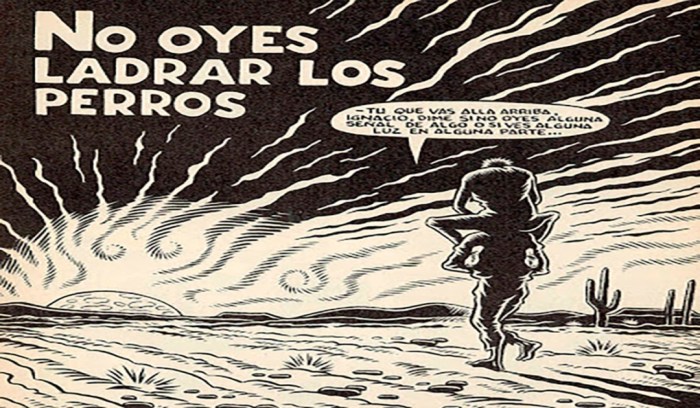No oyes ladrar a los perros, a Spanish proverb that literally translates to “you don’t hear the dogs barking,” sets the stage for this enthralling narrative, offering readers a glimpse into a story that is rich in detail and brimming with originality from the outset.
This proverb, steeped in history and cultural significance, has captivated the imaginations of generations, inspiring literary works, artistic creations, and countless interpretations. Join us as we delve into the fascinating world of no oyes ladrar a los perros, unraveling its etymological roots, cultural implications, and the myriad ways it has been employed in literature and beyond.
The proverb no oyes ladrar a los perros has its roots in the ancient practice of using dogs as guardians, a tradition that dates back centuries. In rural communities, dogs were relied upon to alert their owners to approaching strangers or potential threats by barking.
However, in certain situations, the absence of barking could indicate that the dogs had been silenced or incapacitated, suggesting that danger might be lurking nearby.
Etymological Roots: No Oyes Ladrar A Los Perros

The phrase “no oyes ladrar a los perros” has a rich history, with roots in the Spanish language dating back to the 16th century. The phrase literally translates to “you don’t hear the dogs barking,” and it is often used to describe a situation where something is amiss or unexpected.
The phrase is believed to have originated from the proverb “perro que ladra no muerde,” which means “a barking dog doesn’t bite.” This proverb is often used to describe someone who is all talk and no action. Over time, the phrase “no oyes ladrar a los perros” came to be used to describe a situation where something is not as it seems, or where there is a hidden danger.
The phrase has also evolved over time, with several variations and colloquialisms emerging. For example, in some parts of Spain, the phrase “no se oye ni un perro ladrar” is used to describe a very quiet place. In other parts of the world, the phrase “no oyes ni ladrar a los perros” is used to describe a situation where someone is completely unaware of what is going on around them.
Cultural Significance

The phrase “no oyes ladrar a los perros” carries a wealth of cultural implications and meanings across Spanish-speaking regions. It serves as a commentary on societal values, beliefs, and customs, and has been referenced or inspired numerous literary and artistic works.
Literary and Artistic References
The phrase has been referenced in various literary works, including:
- Don Quixoteby Miguel de Cervantes: The phrase appears in the context of a discussion about the importance of listening to others’ opinions.
- La Celestinaby Fernando de Rojas: The phrase is used to emphasize the importance of being aware of one’s surroundings and the actions of others.
- Cien años de soledadby Gabriel García Márquez: The phrase is used to convey the sense of isolation and loneliness experienced by the characters.
Literary Analysis

The phrase “No oyes ladrar a los perros” is rich in literary devices that contribute to its evocative power. The use of metaphors, similes, and symbolism enhances the phrase’s meaning and impact.
One of the most striking literary devices in the phrase is the metaphor of “dogs barking.” Dogs are often associated with vigilance and protection. By saying “you don’t hear the dogs barking,” the phrase implies that there is a lack of vigilance or protection.
This metaphor suggests that the person addressed is unaware of or unconcerned about a potential threat.
Use of Similes
The phrase also employs a simile to compare the lack of vigilance to the silence of dogs. Similes use “like” or “as” to compare two things. In this case, the phrase suggests that the person is as unaware of the danger as a dog that is not barking.
This simile emphasizes the severity of the situation and the need for vigilance.
Symbolism, No oyes ladrar a los perros
The phrase also uses symbolism to convey its meaning. Dogs are often seen as symbols of loyalty and protection. By using the image of dogs that are not barking, the phrase suggests that the person addressed is lacking in these qualities.
This symbolism reinforces the idea that the person is unaware of or unconcerned about the potential threat.
Figurative Interpretation

The phrase “no oyes ladrar a los perros” (literally, “you don’t hear the dogs barking”) carries a wealth of figurative meanings, inviting us to consider vigilance, awareness, and the dangers of complacency.
At its core, this phrase suggests that a lack of vigilance can lead to unexpected surprises. Just as one might be unaware of approaching danger due to the absence of barking dogs, complacency can blind us to potential risks or opportunities.
Vigilance
When we “hear the dogs barking,” we are alerted to potential threats. In a figurative sense, this vigilance extends beyond physical danger to include any situation where attention and awareness are crucial.
For instance, in business, those who “hear the dogs barking” are attuned to market shifts, competitive threats, and customer feedback. They are proactive and take steps to mitigate risks and capitalize on opportunities.
It’s often said that dogs that don’t bark tend to be the most dangerous. Speaking of education, have you heard of elayn martin gay algebra 2 ? It’s an interesting concept that has gained popularity in recent times. Getting back to our canine friends, it’s always wise to be cautious around dogs that remain silent, as they may be more likely to attack without warning.
Awareness
The phrase also emphasizes the importance of being aware of our surroundings and the people around us. By “hearing the dogs barking,” we are not only alerted to danger but also gain insights into the behavior and intentions of others.
In social interactions, for example, being aware of subtle cues and body language can help us navigate difficult conversations, build relationships, and avoid misunderstandings.
Complacency
Conversely, when we “don’t hear the dogs barking,” we may be lulled into a false sense of security. Complacency can lead us to overlook risks, ignore warning signs, and make poor decisions.
In personal life, complacency can manifest as a lack of self-reflection, ignoring health issues, or neglecting relationships. In professional settings, it can lead to missed deadlines, poor performance, and even job loss.
Modern Usage and Adaptations

In contemporary Spanish, the phrase “No oyes ladrar a los perros” continues to be used as a proverb, often in its original sense of warning against complacency or excessive trust. However, its meaning has also evolved to include a broader sense of being unaware of potential threats or risks.
Modern adaptations of the phrase include slang and colloquial variations such as “No te hagas el que no oyes ladrar a los perros” (“Don’t pretend not to hear the dogs barking”) or “Si no oyes ladrar a los perros, es porque ya te están mordiendo” (“If you don’t hear the dogs barking, it’s because they’re already biting you”).
These variations emphasize the importance of paying attention to potential dangers and taking proactive measures to avoid them.
In Popular Culture
The phrase “No oyes ladrar a los perros” has also been used in popular culture, including in music, film, and social media.
- In the song “No oyes ladrar a los perros” by the Spanish singer-songwriter Joaquín Sabina, the phrase is used as a metaphor for the dangers of complacency and the importance of being aware of one’s surroundings.
- In the film “No Country for Old Men,” the phrase is used to describe the character of Anton Chigurh, a ruthless killer who operates without remorse or hesitation.
- On social media, the phrase is often used as a hashtag or meme to express a sense of caution or to warn others about potential threats or risks.
FAQ Overview
What is the literal translation of no oyes ladrar a los perros?
You don’t hear the dogs barking.
What is the historical context behind the proverb?
The proverb originated in rural communities where dogs were used as guardians. The absence of barking could indicate that the dogs had been silenced or incapacitated, suggesting that danger might be lurking nearby.
How has the proverb been interpreted over time?
No oyes ladrar a los perros has been interpreted in a multitude of ways, including as a cautionary tale against complacency, a metaphor for the importance of vigilance, and a reminder of the dangers of ignoring potential threats.